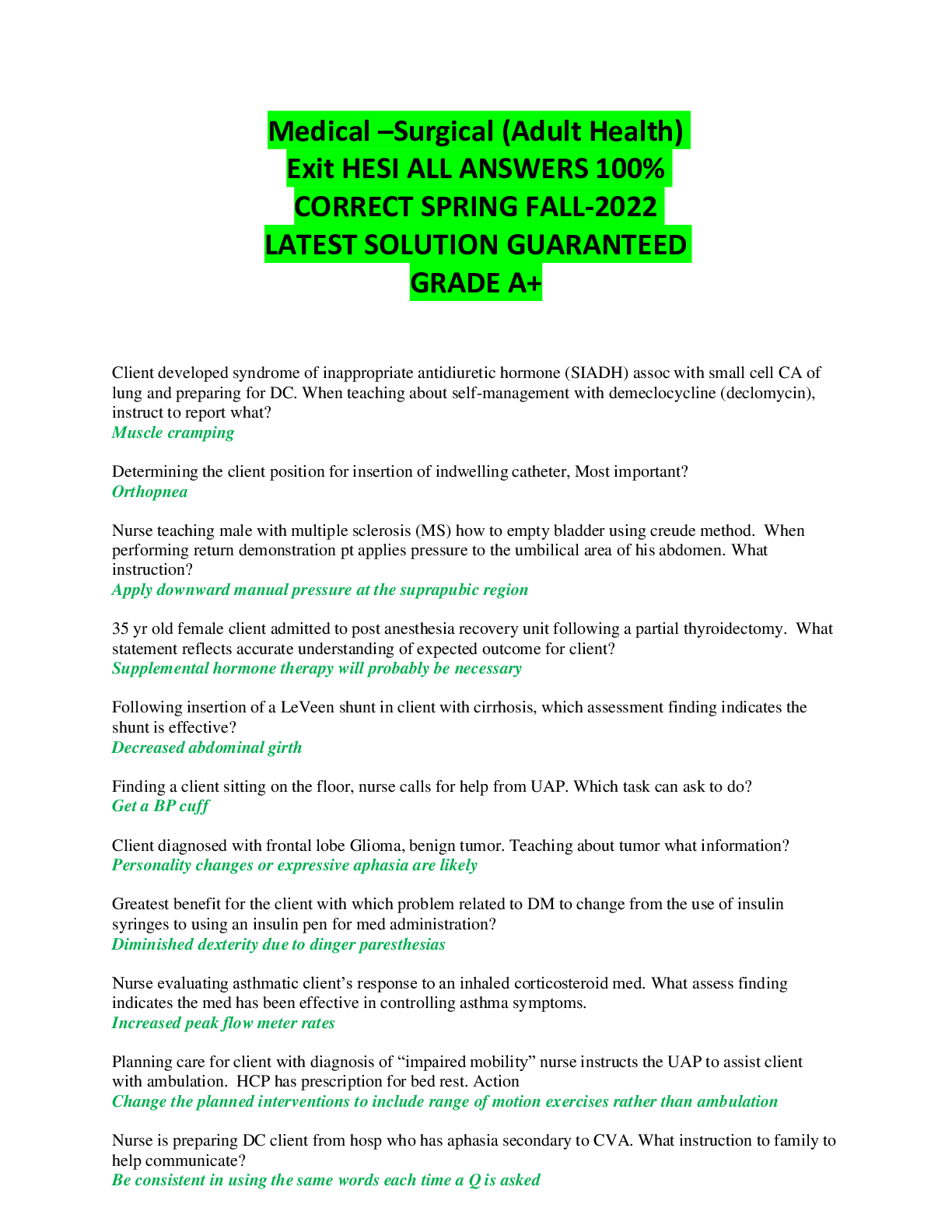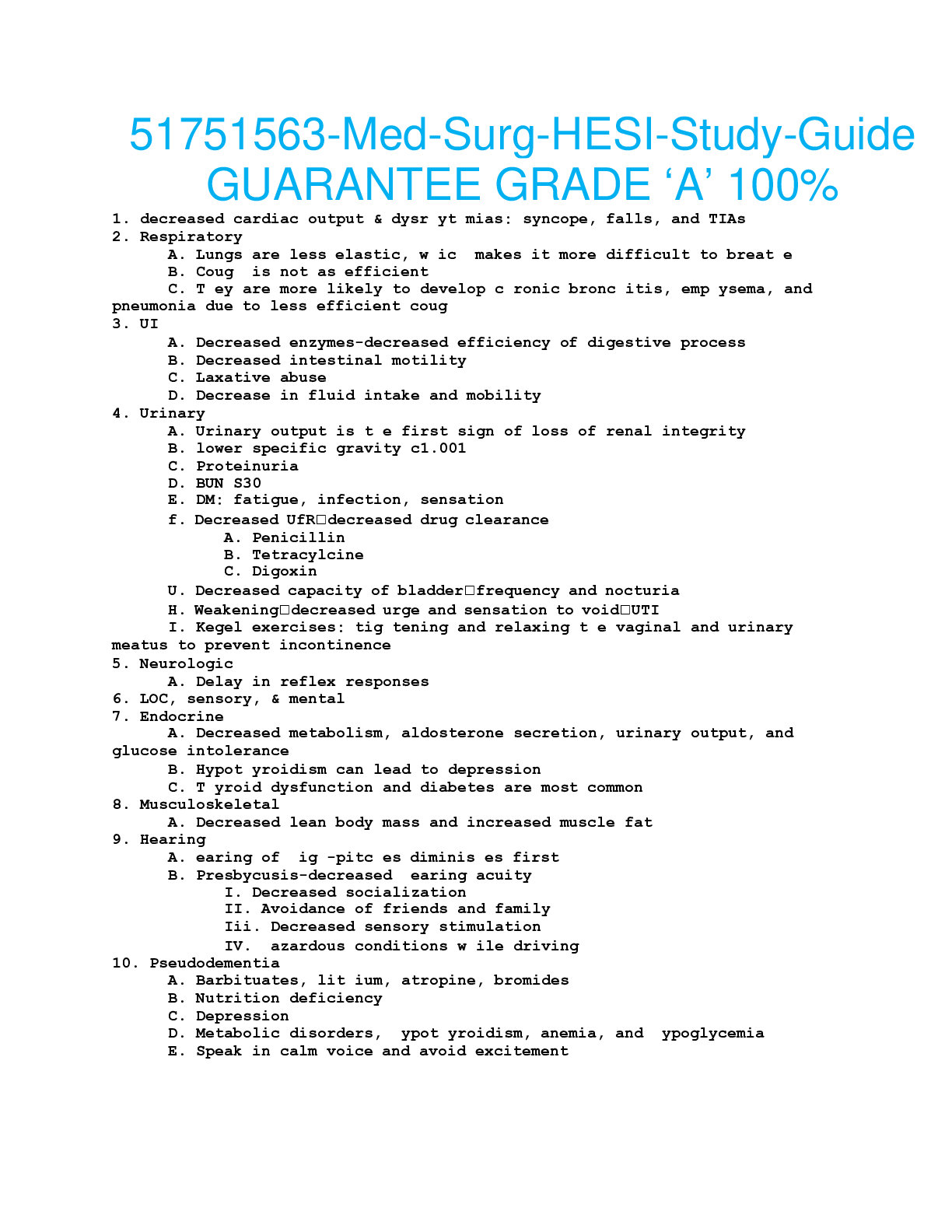*NURSING > HESI MED SURG > MED-SURGE HESI RN questions and answers {with well explained rationales} (All)
MED-SURGE HESI RN questions and answers {with well explained rationales}
Document Content and Description Below
hesi med surg exam An ER nurse is completing an assessment on a patient that is alert but struggles to answer questions. When she attempts to talk, she slurs her speech and appears very frightened.... What additional clinical manifestation does the nurse expect to find if nacy's sysmptoms have been caused by a brain attack (stroke)? Which clinical manifestation further supports an assessment of a left-sided brain attack? When preparing a patient for a noncontrast computed tomography (CT) scan STAT, what nursing intervention should the nurse implement? A neurologist prescribes a magnetic resonance imaging (MRI) of the head STAT for a patient. Which data warrants immediate intervention by the nurse concerning this diagnostic test? A client's daughter is sitting by her mother's bedside who was recently transferred to the Intermediate Care Unit. She states "I don't understand what a brain attack is. The healthcare provider told me my mother is in serious condition and they are going to run several tests. I just don't know what is going on. What happened to my mother?" What is the best response by the nurse? A) " A client was admitted with the diagnosis of a brain attack. Their symptoms began 24 hours before being admitted. Why would this client not be a candidate for for thrombolytic therapy? What are plate guards? Which condition is considered a non-modifiable risk factor for a brain attack? A client is experiencing homonymous hemianopsia as the result of a brain attack. Which nursing intervention would the nurse implement to address this condition? A physical therapist (PT) places a gait belt on a client and is assisting them with ambulation from the bed to the chair. As they get up out of the bed, they report being dizzy and begin to fall. The PT carefully allows them to fall back to the bed and notifies the primary nurse. Which written documentation should the nurse put in the client's record? A new nurse graduate is caring for a postoperative client with the following arterial blood gases (ABGs): pH, 7.30; PCO2, 60 mm Hg; PO2, 80 mm Hg; bicarbonate, 24 mEq/L; and O2 saturation, 96%. Which of these actions by the new graduate is indicated? The nurse is providing dietary instructions to a 68-year-old client who is at high risk for development of coronary heart disease (CHD). Which information should the nurse include? A splint is prescribed for nighttime use by a client with rheumatoid arthritis. Which statement by the nurse provides the most accurate explanation for use of the splints? A 32-year-old female client complains of severe abdominal pain each month before her menstrual period, painful intercourse, and painful defecation. Which additional history should the nurse obtain that is consistent with the client's complaints? A client with a 16-year history of diabetes mellitus is having renal function tests because of recent fatigue, weakness, elevated blood urea nitrogen, and serum creatinine levels. Which finding should the nurse conclude as an early symptom of renal insufficiency? A client with heart disease is on a continuous telemetry monitor and has developed sinus bradycardia. In determining the possible cause of the bradycardia, the nurse assesses the client's medication record. Which medication is most likely the cause of the bradycardia? A client has been taking oral corticosteroids for the past five days because of seasonal allergies. Which assessment finding is of most concern to the nurse? A female client receiving IV vasopressin (Pitressin) for esophageal varice rupture reports to the nurse that she feels substernal tightness and pressure across her chest. Which PRN protocol should the nurse initiate? A client with gastroesophageal reflux disease (GERD) has been experiencing severe reflux during sleep. Which recommendation by the nurse is most effective to assist the client? The nurse is caring for a client with syndrome of inappropriate antidiuretic hormone (SIADH), which is manifested by which symptoms? ................................................................CONTINUED........................................................................ [Show More]
Last updated: 2 years ago
Preview 1 out of 31 pages
 (1).png)
Buy this document to get the full access instantly
Instant Download Access after purchase
Buy NowInstant download
We Accept:

Reviews( 0 )
$12.00
Can't find what you want? Try our AI powered Search
Document information
Connected school, study & course
About the document
Uploaded On
Apr 08, 2021
Number of pages
31
Written in
Additional information
This document has been written for:
Uploaded
Apr 08, 2021
Downloads
0
Views
98



.png)



